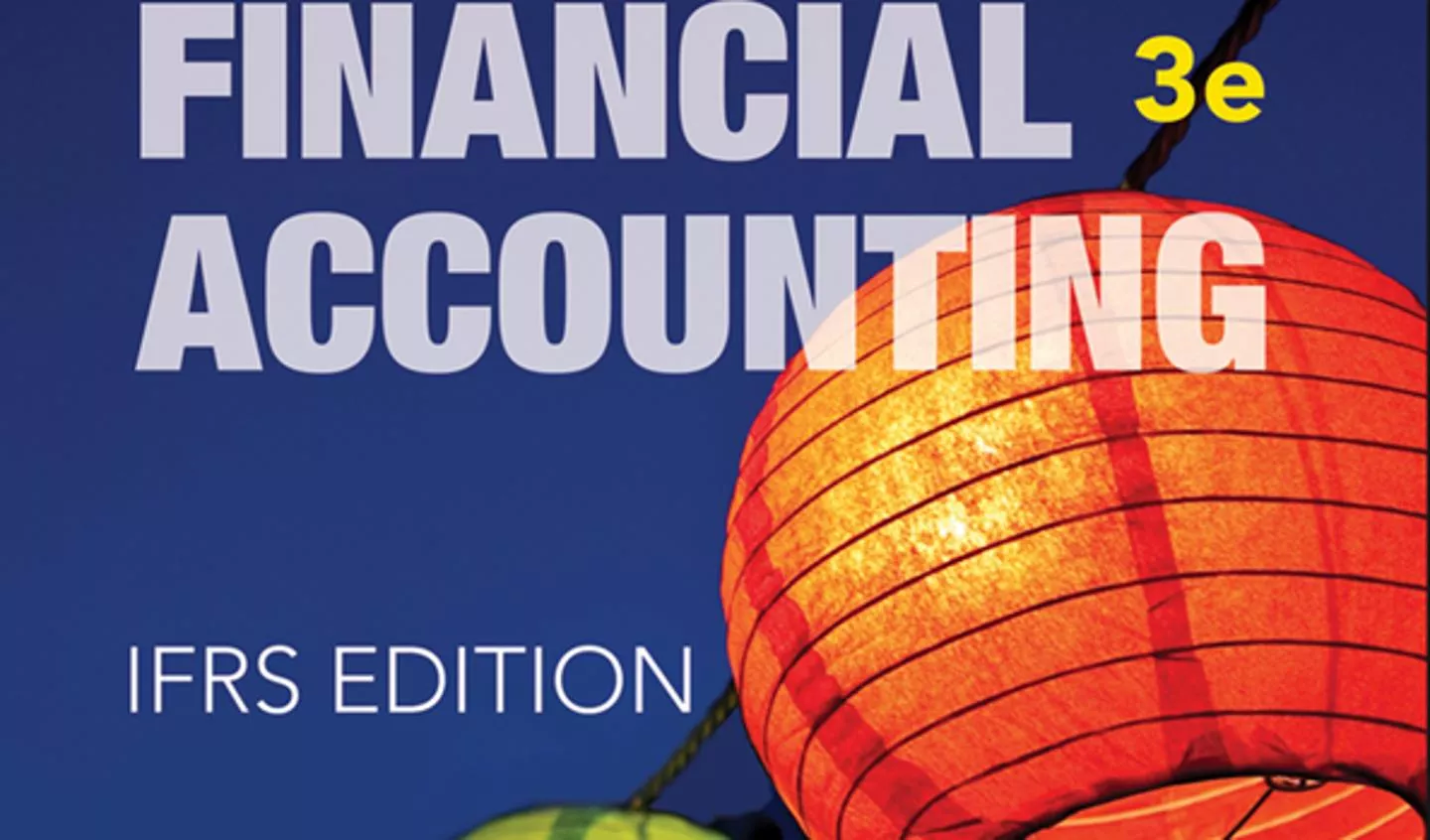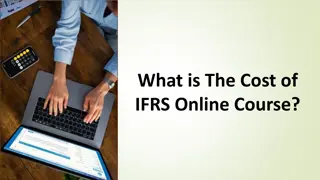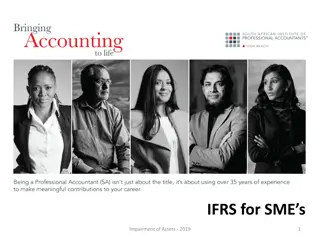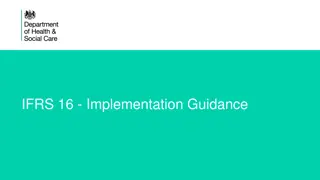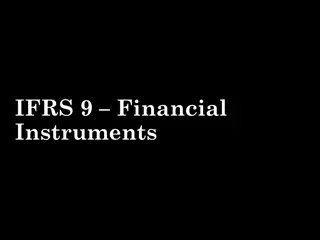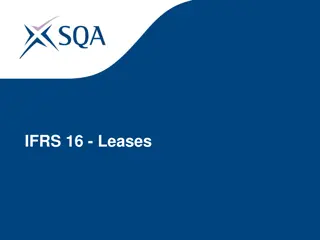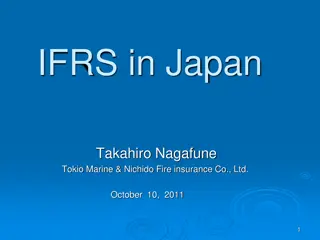Understanding Financial Accounting Principles in IFRS
Explore key concepts in financial accounting such as time period assumption, accrual basis, adjusting entries, and types of accounting methods. Learn about fiscal vs. calendar years and accrual versus cash-basis accounting in the context of International Financial Reporting Standards (IFRS).
Download Presentation

Please find below an Image/Link to download the presentation.
The content on the website is provided AS IS for your information and personal use only. It may not be sold, licensed, or shared on other websites without obtaining consent from the author. Download presentation by click this link. If you encounter any issues during the download, it is possible that the publisher has removed the file from their server.
E N D
Presentation Transcript
WILEY IFRS EDITION IFRS EDITION Prepared by Coby Harmon University of California, Santa Barbara Westmont College 3-1
PREVIEW OF CHAPTER 3 Financial Accounting IFRS 3rd Edition Weygandt Kimmel Kieso 3-2
CHAPTER 3 LEARNING OBJECTIVES Adjusting the Accounts After studying this chapter, you should be able to: 1. Explain the time period assumption. 2. Explain the accrual basis of accounting. 3. Explain the reasons for adjusting entries. 4. Identify the major types of adjusting entries. 5. Prepare adjusting entries for deferrals. 6. Prepare adjusting entries for accruals. 7. Describe the nature and purpose of an adjusted trial balance. 3-3
Timing Issues Learning Objective 1 Explain the time period assumption. Accountants divide the economic life of a business into artificial time periods (Time Period Assumption). . . . . . Jan. Feb. Mar. Apr. Dec. Generally a month, a quarter, or a year. Also known as the Periodicity Assumption LO 1 3-4
Fiscal and Calendar Years Monthly and quarterly time periods are called interim periods. Most large companies must prepare both quarterly and annual financial statements. Fiscal Year = Accounting time period that is one year in length. Calendar Year = January 1 to December 31. LO 1 3-5
Fiscal and Calendar Years Question The time period assumption states that: a. companies must wait until the calendar year is completed to prepare financial statements. b. companies use the fiscal year to report financial information. c. the economic life of a business can be divided into artificial time periods. d. companies record information in the time period in which the events occur. LO 1 3-6
Accrual- versus Cash-Basis Accounting Learning Objective 2 Explain the accrual basis of accounting. Accrual-Basis Accounting Transactions recorded in the periods in which the events occur. Companies recognizerevenues when theyperform services (rather than when they receive cash). Expenses are recognized when incurred (rather than when paid). LO 2 3-7
Accrual- versus Cash-Basis Accounting Cash-Basis Accounting Revenues are recorded when cash is received. Expenses are recorded when cash is paid. Cash-basis accounting is not in accordance with International Financial Reporting Standards (IFRS). LO 2 3-8
Recognizing Revenues and Expenses REVENUE RECOGNITION PRINCIPLE Recognize revenue in the accounting period in which the performance obligation is satisfied. LO 2 3-9
Recognizing Revenues and Expenses EXPENSE RECOGNITION PRINCIPLE Match expenses with revenues in the period when the company makes efforts to generate those revenues. Let the expenses follow the revenues. LO 2 3-10
Illustration 3-1 IFRS relationships in revenue and expense recognition LO 2 3-11
Recognizing Revenues and Expenses Question The revenue recognition principle states that: a. revenue should be recognized in the accounting period in which a performance obligation is satisfied. b. expenses should be matched with revenues. c. the economic life of a business can be divided into artificial time periods. d. the fiscal year should correspond with the calendar year. LO 2 3-12
Why Accuracy Matters ETHICS INSIGHT Krispy Kreme (USA) Cooking the Books? Allegations of abuse of the revenue recognition principle have become all too common in recent years. For example, it was alleged that Krispy Kreme (USA) sometimes doubled the number of doughnuts shipped to wholesale customers at the end of a quarter to boost quarterly results. The customers shipped the unsold doughnuts back after the beginning of the next quarter for a refund. Conversely, Computer Associates International (USA) was accused of backdating sales that is, reporting a sale in one period that did not actually occur until the next period in order to achieve the earlier period s sales targets. LO 2 3-13
DO IT! > A list of concepts is provided in the left column below, with a description of the concept in the right column below. There are more descriptions provided than concepts. Match the description of the concept to the concept. 1. ___ Accrual-basis accounting. f (a) Monthly and quarterly time periods. (b) Efforts (expenses) should be matched with results (revenues). (c) Accountants divide the economic life of a business into artificial time periods. (d) Companies record revenues when they receive cash and record expenses when they pay out cash. (e) An accounting time period that starts on January 1 and ends on December 31. (f) Companies record transactions in the period in which the events occur. 2. ___ Calendar year. e 3. ___ Time period assumption. c b 4. ___ Expense recognition principle. LO 2 3-14
The Basics of Adjusting Entries Learning Objective 3 Explain the reasons for adjusting entries. Adjusting Entries Ensure that the revenue recognition and expense recognition principles are followed. Necessary because the trial balance may not contain up-to-date and complete data. Required every time a company prepares financial statements. Will include one income statement account and one statement of financial position account. LO 3 3-15
Adjusting Entries Question Adjusting entries are made to ensure that: a. expenses are recognized in the period in which they are incurred. b. revenues are recorded in the period in which services are performed. c. statement of financial position and income statement accounts have correct balances at the end of an accounting period. d. All the responses above are correct. LO 3 3-16
Types of Adjusting Entries Learning Objective 4 Identify the major types of adjusting entries. Deferrals Accruals 1. Accrued Revenues. Revenues for services performed but not yet received in cash or recorded. 1. Prepaid Expenses. Expenses paid in cash before they are used or consumed. 2. Unearned Revenues. Cash received before services are performed. 2. Accrued Expenses. Expenses incurred but not yet paid in cash or recorded. Illustration 3-2 Categories of adjusting entries LO 4 3-17
Illustration 3-3 Trial balance Each account is analyzed to determine whether it is complete and up-to-date for financial statement purposes. LO 4 3-18
Adjusting Entries for Deferrals Learning Objective 5 Prepare adjusting entries for deferrals. Deferrals are expenses or revenues that are recognized at a date later than the point when cash was originally exchanged. There are two types: Prepaid expenses and Unearned revenues. LO 5 3-19
PREPAID EXPENSES Payments of expenses that will benefit more than one accounting period. Cash Payment BEFORE Expense Recorded Prepayments often occur in regard to: rent insurance buildings and equipment supplies advertising LO 5 3-20




